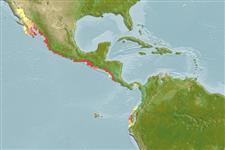Actinopterygii (ray-finned fishes) >
Anguilliformes (Eels and morays) >
Chlopsidae (False morays)
Etymology: Chlopsis: Greek, chloea = green + Greek, opsis = appearance (Ref. 45335); kazuko: Named in honor of Kazuko Nakamura in recognition of her faithful and dedicated service to the LACM section of fishes by single-handedly archiving the Giles W. Mead ichthyological library (Ref. 40870).
Environment / Climate / Range
Ecology
Marine; demersal; depth range 50 - 100 m (Ref. 96339). Tropical, preferred ?
Eastern Central Pacific: Gulf of California. Mexico southward to Costa Rica (Ref. 97056).
Size / Weight / Age
Maturity: Lm ? range ? - ? cm
Max length : 11.3 cm SL male/unsexed; (Ref. 40870)
Short description
Morphology | Morphometrics
Vertebrae: 123 - 126. Head and body pigment uniformly distributed and sharply demarcated, heavily pigmented dorsally and unpigmented ventrally; dorsal fin origin over or in front of gill opening (Ref. 40870).
Life cycle and mating behavior
Maturity | Reproduction | Spawning | Eggs | Fecundity | Larvae
Lavenberg, R.J., 1988. Chlopsid eels of the eastern Pacific with a new species and descriptions of larval forms. Bull. Mar. Sci. 42(2):253-264. (Ref. 40870)
IUCN Red List Status (Ref. 115185)
CITES (Ref. 94142)
Not Evaluated
Threat to humans
Harmless
Human uses
More information
Common namesSynonymsMetabolismPredatorsEcotoxicologyReproductionMaturitySpawningFecundityEggsEgg development
Age/SizeGrowthLength-weightLength-lengthLength-frequenciesMorphometricsMorphologyLarvaeLarval dynamicsRecruitmentAbundance
ReferencesAquacultureAquaculture profileStrainsGeneticsAllele frequenciesHeritabilityDiseasesProcessingMass conversion
Tools
Special reports
Download XML
Internet sources
Estimates of some properties based on models
Phylogenetic diversity index (Ref.
82805): PD
50 = 0.5020 [Uniqueness, from 0.5 = low to 2.0 = high].
Bayesian length-weight: a=0.00102 (0.00046 - 0.00225), b=3.06 (2.88 - 3.24), in cm Total Length, based on all LWR estimates for this body shape (Ref.
93245).
Trophic Level (Ref.
69278): 3.5 ±0.5 se; Based on size and trophs of closest relatives
Resilience (Ref.
69278): .
Vulnerability (Ref.
59153): Low vulnerability (10 of 100) .
